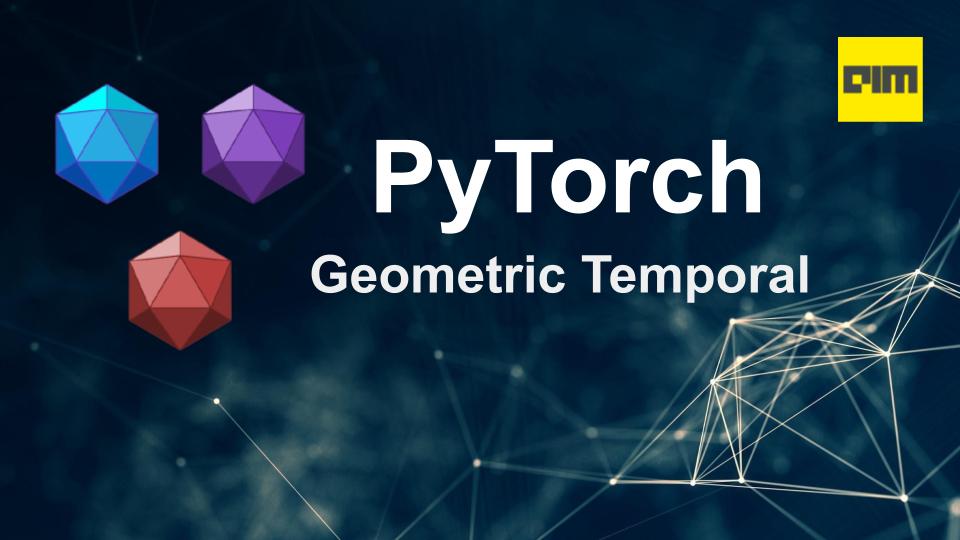PyTorch Geometric Temporal is a temporal extension of PyTorch Geometric(PyG) framework, which we have covered in our previous article. This open-source python library’s central idea is more or less the same as Pytorch Geometric but with temporal data. Like PyG, PyTorch Geometric temporal is also licensed under MIT. It contains many dynamic and temporal state-of-the-art deep learning algorithms or Geometric Deep learning algorithms for spatio-temporal signals. It also provides an easy-to-use mini-batch loader/dataloader, multi GPU-support, benchmark datasets and an iterator for dynamic and temporal graphs. The keys points of the framework are :
- On both dynamic and static graphs, it offers discrete-time graph neural networks.
- When the time period is continuous, it allows for spatio-temporal learning without the use of discrete snapshots.
Methods included in PyTorch Geometric Temporal.
- Discrete Recurrent Graph Convolutions
- Temporal Graph Convolutions
- Auxiliary Graph Convolutions
You can check all the algorithms supported by it, here.
Without further ado, let’s begin with the code part!
Requirements & Installation
Install all the requirements of PyTorch Geometric Temporal and then install it via PyPI.
- PyTorch >= 1.4.0
For checking the version of PyTorch, run the mentioned code:
!python -c "import torch; print(torch.__version__)"
- Check the version of CUDA installed with PyTorch.
!python -c "import torch; print(torch.version.cuda)"
- Install the dependencies :
The code is for PyTorch version = 1.7.0 and replaces ${CUDA} with the CUDA version which you are using.
%%bash
pip install torch-scatter==latest+${CUDA} -f https://pytorch-geometric.com/whl/torch-1.7.0.html
pip install torch-sparse==latest+${CUDA} -f https://pytorch-geometric.com/whl/torch-1.7.0.html
pip install torch-cluster==latest+${CUDA} -f https://pytorch-geometric.com/whl/torch-1.7.0.html
pip install torch-spline-conv==latest+${CUDA} -f https://pytorch-geometric.com/whl/torch-1.7.0.html
- Install PyTorch Geometric:
!pip install torch-geometric
- Install the required framework:
!pip install torch-geometric-temporal
Data Structures
This part will briefly talk about the data structures provided by PyTorch Geometric Temporal Framework.
Discrete Dataset Iterators
There are two types of discrete data iterators provided by PyTorch Geometric Temporal:
- Statistics Graphs with Discrete Signal : Used of discrete spatio-temporal signals on a static graph, the constructor is defined as StaticGraphDiscreteSignal which has the following parameter requirements:
- edge_index – A NumPy array to hold the edge indices.
- edge_weight – A NumPy array to hold the edge weights.
- features – A list of NumPy arrays to hold the vertex features for each time period.
- targets – A list of NumPy arrays to hold the vertex level targets for each time period.
- Static Graphs with Dynamic Signal : Used of discrete spatio-temporal signals on a dynamic graph, the constructor is defined as DynamicGraphDiscreteSignal which has the following parameter requirements:
- edge_indices – A list of NumPy arrays to hold the edge indices.
- edge_weights – A list of NumPy arrays to hold the edge weights.
- features – A list of NumPy arrays to hold the vertex features for each time period.
- targets – A list of NumPy arrays to hold the vertex level targets for each time period.
Temporal Snapshots: It is a discrete temporal Data object, functions same as the Data object discussed in PyTorch Geometric.
Benchmark Datasets
There are many datasets provided by PyTorch Geometric Temporal framework for the comparison of performance of GNN algorithms
Discrete Time Datasets : To import Hungarian Chickenpox Dataset discrete dataset, the code snippet is available below:
from torch_geometric_temporal.data.dataset import ChickenpoxDatasetLoader loader = ChickenpoxDatasetLoader() #get_dataset is the method of StaticGraphDiscreteSignal object dataset = loader.get_dataset()
Train-Test Splitter
Discrete train-test splitter, splits the temporal and return train and test iterators generated from discrete time iterators using a fix ratio. The function of discrete_train_test_split is the same as scikit’s train_test_split. On an input of any StaticGraphDiscreteSignal or a DynamicGraphDiscreteSignal, discrete_train_test_split returns two iterators splitted according to the train_ratio.
from torch_geometric_temporal.data.dataset import ChickenpoxDatasetLoader from torch_geometric_temporal.data.splitter import discrete_train_test_split loader = ChickenpoxDatasetLoader() dataset = loader.get_dataset() train_dataset, test_dataset = discrete_train_test_split(dataset, train_ratio=0.8)
Applications of PyTorch Geometric Temporal
This section will provide you an overview of how PyG Temporal is used in real-world scenarios.
Learning from a Discrete Temporal Signal
The following demo trains a regressor to predict the weekly Chickenpox cases reported by the country. The dataset used for it is Hungarian Chickenpox Dataset.
- Load the dataset and divide the iterator into train set and test set.
from torch_geometric_temporal.data.dataset import ChickenpoxDatasetLoader from torch_geometric_temporal.data.splitter import discrete_train_test_split loader = ChickenpoxDatasetLoader() dataset = loader.get_dataset() train_dataset, test_dataset = discrete_train_test_split(dataset, train_ratio=0.2)
- Next step is to create a Recurrent Graph Neural Network(RGNN) for supervised learning. The fundamental design of the architecture is the same as PyTorch Geometric. The RecurrentGNN function Object() {RecurrentGCN } generates a DCRNN and a feedforward layer, and the ReLU activation function is used to manually establish non linearity between the recurrent and linear layers.
import torch import torch.nn.functional as F from torch_geometric_temporal.nn.recurrent import DCRNN class RecurrentGCN(torch.nn.Module): def __init__(self, node_features): super(RecurrentGCN, self).__init__() self.recurrent = DCRNN(node_features, 32, 1) self.linear = torch.nn.Linear(32, 1) def forward(self, x, edge_index, edge_weight): h = self.recurrent(x, edge_index, edge_weight) h = F.relu(h) h = self.linear(h) return h
- Train the model on the train_dataset for 200 epochs by back propagating the loss from every snapshot. The Adam optimizer is used with a learning rate of 0.01.
from tqdm import tqdm model = RecurrentGCN(node_features = 4) optimizer = torch.optim.Adam(model.parameters(), lr=0.01) model.train() for epoch in tqdm(range(200)): cost = 0 for time, snapshot in enumerate(train_dataset): y_hat = model(snapshot.x, snapshot.edge_index, snapshot.edge_attr) cost = cost + torch.mean((y_hat-snapshot.y)**2) cost = cost / (time+1) cost.backward() optimizer.step() optimizer.zero_grad()
- Finally, run a test dataset to assess the model’s output and measure the Mean Squared Error (MSE) for all spatial units and time periods.
model.eval()
cost = 0
for time, snapshot in enumerate(test_dataset):
y_hat = model(snapshot.x, snapshot.edge_index, snapshot.edge_attr)
cost = cost + torch.mean((y_hat-snapshot.y)**2)
cost = cost / (time+1)
cost = cost.item()
print("MSE: {:.4f}".format(cost))
Colab Notebook : PyTorch Geometric Temporal Demo
References :
Official codes, Documentation and Tutorials are available at :







































































































